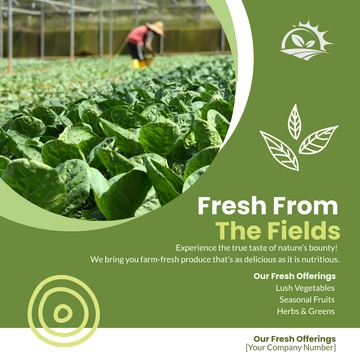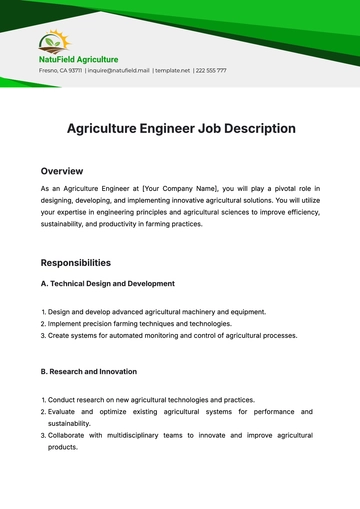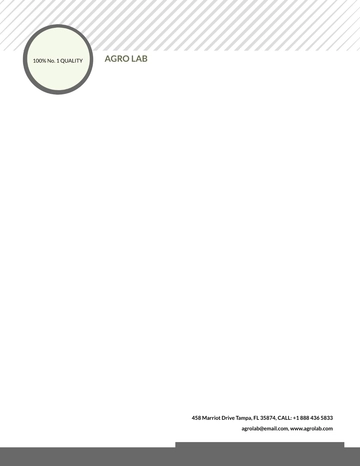Free Agriculture Staffing Study

Introduction
Staffing is a critical component of successful agricultural operations. Ensuring the right number of qualified and motivated employees is essential for maintaining productivity, efficiency, and sustainability. This comprehensive staffing study aims to provide an in-depth analysis of the current staffing situation at [Your Company Name], identify key staffing needs, and propose strategic recommendations for optimizing workforce management. The study includes an assessment of current staffing levels, an analysis of future staffing requirements, a review of recruitment and retention strategies, and an evaluation of training and development programs.
1. Current Staffing Assessment
Understanding the current staffing situation is crucial for identifying strengths and areas for improvement. This chapter provides an overview of the current workforce, including employee demographics, skill levels, and staffing levels in various departments.
1.1 Workforce Demographics
Objective: To analyze the demographic composition of the current workforce.
Data Analysis:
Metric | Value |
|---|---|
Total Employees | 200 |
Average Age | 37 years |
Gender Distribution | 55% Male, 45% Female |
Average Tenure | 4.5 years |
Diversity Rate | 28% |
The demographic analysis reveals a diverse workforce with a balanced gender distribution and a significant proportion of employees with long tenure, indicating stability and experience within the company.
1.2 Skill Levels
Objective: To assess the skill levels of employees in different roles.
Data Analysis:
Department | Skill Level (High/Medium/Low) | Percentage of High-Skilled Employees |
|---|---|---|
Field Operations | Medium | 40% |
Equipment Maintenance | High | 60% |
Administration | High | 70% |
Research & Development | Medium | 50% |
Sales & Marketing | Medium | 45% |
The skill level assessment shows that while certain departments, such as Equipment Maintenance and Administration, have a high proportion of skilled employees, other areas like Field Operations and Sales & Marketing have room for improvement in skill enhancement.
1.3 Staffing Levels by Department
Objective: To evaluate the staffing levels in various departments to ensure optimal workforce distribution.
Data Analysis:
Department | Current Staff | Optimal Staff | Variance |
|---|---|---|---|
Field Operations | 80 | 90 | -10 |
Equipment Maintenance | 30 | 35 | -5 |
Administration | 25 | 25 | 0 |
Research & Development | 40 | 50 | -10 |
Sales & Marketing | 25 | 30 | -5 |
The staffing level analysis indicates a need for additional staff in Field Operations, Equipment Maintenance, Research & Development, and Sales & Marketing to meet optimal operational requirements.
2. Future Staffing Requirements
Accurately forecasting future staffing needs is essential for strategic workforce planning. This chapter examines the factors influencing future staffing requirements, including business growth, technological advancements, and market trends.
2.1 Business Growth Projections
Objective: To project future staffing needs based on business growth and expansion plans.
Data Analysis:
Year | Projected Revenue | Required Headcount | Growth Rate (%) |
|---|---|---|---|
2051 | $25 million | 220 | 10% |
2052 | $27.5 million | 240 | 9% |
2053 | $30 million | 260 | 8% |
2054 | $33 million | 280 | 7% |
2055 | $36 million | 300 | 7% |
The business growth projections indicate a steady increase in revenue, necessitating a proportional increase in staffing levels to support expanded operations and maintain service quality.
2.2 Technological Advancements
Objective: To evaluate the impact of technological advancements on staffing needs.
Analysis:
Automation: Adoption of automation technologies in equipment maintenance and field operations will reduce the need for manual labor but increase the demand for skilled technicians and engineers.
Precision Agriculture: Implementation of precision agriculture tools will require staff with expertise in data analysis and advanced farming techniques.
Sustainable Practices: Emphasis on sustainable farming practices will necessitate training and hiring personnel knowledgeable in environmental management and sustainability.
2.3 Market Trends
Objective: To identify market trends that influence staffing requirements.
Analysis:
Consumer Preferences: Growing consumer demand for organic and sustainably produced food will require additional staff to manage organic certification and compliance.
Regulatory Changes: Changes in agricultural regulations may require hiring compliance officers and specialists in agricultural law.
Global Trade: Expanding into new international markets will necessitate hiring multilingual staff and experts in global agricultural trade.
3. Recruitment and Retention Strategies
Attracting and retaining a skilled workforce is vital for sustained success. This chapter outlines strategies for effective recruitment and retention, ensuring that [Your Company Name] remains competitive in the labor market.
3.1 Recruitment Strategies
Objective: To attract a diverse pool of qualified candidates.
Strategies:
Employer Branding: Develop a strong employer brand that highlights the company’s commitment to sustainability, innovation, and employee development.
Diverse Recruitment Channels: Utilize multiple recruitment channels, including job boards, social media, industry networks, and recruitment agencies, to reach a broad audience.
Internship and Apprenticeship Programs: Partner with educational institutions to create internship and apprenticeship programs that provide hands-on experience and a pipeline for future hires.
Table: Recruitment Channels
Channel | Reach | Effectiveness |
|---|---|---|
Job Boards | National | High |
Social Media | Global | Medium |
Industry Networks | Targeted | High |
Recruitment Agencies | Regional | Medium |
Internship Programs | Local | High |
3.2 Retention Strategies
Objective: To retain top talent and reduce turnover.
Strategies:
Competitive Compensation: Offer competitive salaries and benefits packages to attract and retain skilled employees.
Career Development: Provide clear career advancement opportunities and pathways, including professional development programs, mentorship, and leadership training.
Employee Engagement: Implement regular engagement initiatives, such as team-building activities, social events, and recognition programs, to foster a positive work environment.
Table: Retention Strategies
Strategy | Implementation | Impact |
|---|---|---|
Competitive Compensation | Ongoing | High |
Career Advancement | Ongoing | High |
Employee Engagement | Ongoing | Medium |
Mentorship Programs | Ongoing | Medium |
4. Training and Development
Continuous learning and skill development are essential for maintaining a competitive edge in the agricultural industry. This chapter outlines our approach to training and development, ensuring that employees have the knowledge and skills required to excel in their roles.
4.1 Training Programs
Objective: To provide employees with the skills and knowledge needed for their current roles and future growth.
Strategies:
Technical Skills Training: Develop a comprehensive training curriculum that includes technical skills, safety protocols, and soft skills.
Blended Learning: Offer a mix of training methods, including on-the-job training, classroom instruction, e-learning, and workshops.
Certifications: Support employees in obtaining professional certifications relevant to their roles.
Table: Training Programs
Program | Duration | Target Audience |
|---|---|---|
Technical Skills Training | 2 weeks | Equipment Operators |
Safety Training | Ongoing | All Employees |
Leadership Development | 3 months | Supervisors, Managers |
Soft Skills Training | 1 week | Customer Service Staff |
4.2 Continuous Professional Development
Objective: To encourage ongoing learning and career advancement.
Strategies:
Industry Conferences: Provide opportunities for employees to attend industry conferences, seminars, and workshops.
Tuition Assistance: Support employees in pursuing advanced degrees and professional certifications through tuition reimbursement programs.
Internal Workshops: Organize quarterly workshops focused on emerging technologies, industry trends, and best practices.
Table: Professional Development Opportunities
Opportunity | Frequency | Support Provided |
|---|---|---|
Industry Conferences | Annually | Travel and Registration Fees |
Certification Programs | As Needed | Tuition Reimbursement |
Advanced Degrees | As Needed | Tuition Assistance |
Internal Workshops | Quarterly | Onsite Training Sessions |
5. Workforce Diversity and Inclusion
Promoting diversity and inclusion within the workforce is essential for fostering innovation and creativity. This chapter outlines our strategies for enhancing workforce diversity and creating an inclusive work environment.
5.1 Diversity Initiatives
Objective: To build a diverse workforce that reflects the communities we serve.
Strategies:
Inclusive Recruitment: Implement recruitment practices that ensure diverse candidate pools, such as blind resume screening and diverse interview panels.
Partnerships: Partner with organizations and educational institutions that support underrepresented groups in agriculture.
Employee Resource Groups (ERGs): Establish ERGs to provide support and networking opportunities for employees from diverse backgrounds.
Table: Diversity Initiatives
Initiative | Implementation | Impact |
|---|---|---|
Inclusive Recruitment | Ongoing | High |
Partnerships | Ongoing | Medium |
Employee Resource Groups | Ongoing | Medium |
5.2 Inclusion Strategies
Objective: To create an inclusive work environment where all employees feel valued and respected.
Strategies:
Inclusive Policies: Develop and enforce policies that promote inclusion, such as flexible work arrangements and anti-discrimination policies.
Training: Provide diversity and inclusion training for all employees, including unconscious bias training and cultural competency workshops.
Feedback Mechanisms: Implement feedback mechanisms, such as surveys and focus groups, to gather input on inclusion efforts and identify areas for improvement.
Table: Inclusion Strategies
Strategy | Implementation | Impact |
|---|---|---|
Inclusive Policies | Ongoing | High |
Diversity and Inclusion Training | Quarterly | Medium |
Feedback Mechanisms | Ongoing | Medium |
6. Health and Safety
Ensuring the health and safety of our employees is a top priority. This chapter outlines our health and safety protocols, including hazard identification, emergency response, and training programs.
6.1 Hazard Identification and Mitigation
Objective: To identify and mitigate workplace hazards to prevent accidents and injuries.
Strategies:
Safety Inspections: Conduct regular safety inspections to identify potential hazards.
Corrective Actions: Implement corrective actions to mitigate identified hazards.
Reporting: Encourage employees to report any safety concerns or hazards.
Table: Hazard Identification and Mitigation
Activity | Frequency | Responsible Party |
|---|---|---|
Safety Inspections | Monthly | Safety Officer |
Corrective Actions | As Needed | Operations Manager |
Hazard Reporting | Ongoing | All Employees |
6.2 Emergency Response
Objective: To ensure a prompt and effective response to emergencies.
Strategies:
Emergency Plan: Develop and maintain an emergency response plan that includes procedures for fire, chemical spills, and medical emergencies.
Drills: Conduct regular emergency drills and training sessions.
Training: Ensure all employees are familiar with emergency procedures and the location of emergency equipment.
Table: Emergency Response
Activity | Frequency | Responsible Party |
|---|---|---|
Emergency Plan Review | Annually | Safety Officer |
Emergency Drills | Quarterly | Safety Officer |
Emergency Training | Ongoing | Safety Officer |
6.3 Safety Training Programs
Objective: To educate employees on safe work practices and procedures.
Strategies:
Orientation: Provide comprehensive safety training during the onboarding process.
Ongoing Training: Offer ongoing safety training and refresher courses.
Update Materials: Keep training materials up-to-date and aligned with industry standards and regulations.
Table: Safety Training Programs
Program | Frequency | Target Audience |
|---|---|---|
Orientation Safety Training | Onboarding | New Employees |
Refresher Safety Training | Annually | All Employees |
Specialized Safety Training | As Needed | High-Risk Roles |
7. Compliance and Documentation
Compliance with legal and regulatory requirements is essential for maintaining the integrity and reputation of our organization. This chapter outlines our approach to ensuring compliance and maintaining accurate documentation.
7.1 Regulatory Compliance
Objective: To ensure adherence to all relevant agricultural and labor regulations.
Strategies:
Legal Updates: Stay informed about changes in laws and regulations that affect agricultural operations.
Policies and Procedures: Implement policies and procedures that comply with legal requirements.
Audits: Conduct regular audits to ensure compliance with all regulations.
Table: Regulatory Compliance
Activity | Frequency | Responsible Party |
|---|---|---|
Legal Updates | Ongoing | Legal Department |
Policy Review | Annually | HR Department |
Compliance Audits | Quarterly | Compliance Officer |
7.2 Record-Keeping
Objective: To maintain accurate and comprehensive records of all operational activities.
Strategies:
Detailed Records: Keep detailed records of planting, harvesting, and production activities.
Maintenance Logs: Maintain equipment maintenance logs and safety inspection reports.
Documentation: Document all training sessions, performance reviews, and employee development activities.
Table: Record-Keeping
Activity | Frequency | Responsible Party |
|---|---|---|
Planting and Harvesting Records | Ongoing | Farm Manager |
Maintenance Logs | Ongoing | Maintenance Team |
Training Documentation | Ongoing | HR Department |
7.3 Reporting
Objective: To provide regular reports on operational performance and compliance status.
Strategies:
Monthly Reports: Prepare monthly and annual reports on key performance indicators (KPIs) and compliance metrics.
Communication: Communicate report findings to management and relevant stakeholders.
Improvement: Use report data to identify areas for improvement and implement corrective actions.
Table: Reporting
Activity | Frequency | Responsible Party |
|---|---|---|
Monthly Reports | Monthly | Department Heads |
Annual Reports | Annually | HR and Compliance |
Stakeholder Communication | Quarterly | Management |
Conclusion
Developing and implementing a comprehensive workforce strategy is essential for the success and sustainability of agricultural operations at [Your Company Name]. By focusing on effective workforce planning, recruitment, training, employee engagement, performance management, diversity and inclusion, health and safety, and compliance, we can build a skilled, motivated, and compliant workforce. This strategy not only supports our business objectives but also ensures a positive work environment where employees feel valued and supported.
- 100% Customizable, free editor
- Access 1 Million+ Templates, photo’s & graphics
- Download or share as a template
- Click and replace photos, graphics, text, backgrounds
- Resize, crop, AI write & more
- Access advanced editor
Enhance your workforce planning with Template.net's Agriculture Staffing Study Template. Tailored for agricultural operations, this customizable and editable template using our AI editor tool allows you to analyze and optimize staffing levels based on operational needs and productivity data. Ideal for HR professionals seeking to align staffing with seasonal fluctuations and business growth objectives.





























